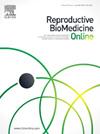RELATIONSHIP OF SIRI (SYSTEMIC INFLAMMATION RESPONSE INDEX) AND SII (SYSTEMIC IMMUNE INFLAMMATION INDEX) VALUES WITH INTRAUTERINE DEVICE (IUD) DISLOCATION
IF 3.7
2区 医学
Q1 OBSTETRICS & GYNECOLOGY
引用次数: 0
Abstract
Objective
The rate of using the Intrauterine Device (IUD), which is the most frequently preferred birth control method among women in Turkey, is approximately 19-25%. Systemic Inflammation Response Index (SIRI) and Systemic Immuno-Inflammation Index (SII) are new prognostic markers emphasized in the literature in the evaluation of cancer prognosis and inflammatory processes. In our study, we aimed to evaluate whether the SIRI and SII values obtained from the hemogram examinations taken from the patients during IUD insertion have an effect on predicting the dislocation of the IUD.
Materials and Methods
303 patients who applied to Ankara Etlik City Hospital Family Planning Polyclinic were included in the study. Data of patients who came for IUD control were scanned retrospectively and data of patients whose hemogram values were checked while IUD was inserted one month ago were recorded. Those with known additional diseases and systemic infections were not included in the study. Since the SIRI and SII measurements did not have normal distribution, nonparametric analysis techniques were used such as Mann-Whitney U test. Confidence interval was determined as 95% and p<0.05 values were considered statistically significant.
Results
In our clinic, in the controls one month after the copper IUDs are placed in the intrauterine cavity, we see dislocated IUDs in approximately 10%. This may be related to many factors. According to the analysis, the SIRI measurements of the groups evaluated as dislocated IUD in the control USG were higher than those with normally placed IUDs, but this difference was not statistically significant (p = 0.07). No significant difference was detected between the SII measurements of the normally placed and dislocated groups in the control USG (p = 0.90).
Discussion and Conclusion
Dislocation of IUD causes pain, bleeding and unwanted pregnancies in patients, and also increases hospital admissions and costs. It is not known in which patient and for what reason IUD is dislocated. In our study, we investigated whether SIRI and SII values obtained from hemogram examinations taken at the time of application of patients will have an effect on predicting IUD dislocation. SIRI values of patients with dislocated IUD at the time of application were higher, but the difference was not statistically significant (p:0.07). No significant difference was found between SII values of patients with dislocated IUD. If it is determined that SIRI value is a valuable parameter in predicting IUD dislocation, it will be possible to plan the time of IUD insertion more accurately without any additional examination. This could prevent complications such as bleeding, pain, unwanted pregnancy, removal and re-insertion of the IUD, and will reduce costs. Although no significant relationship was found in our study, more comprehensive prospective studies are needed in larger patient populations.
求助全文
约1分钟内获得全文
求助全文
来源期刊

Reproductive biomedicine online
医学-妇产科学
CiteScore
7.20
自引率
7.50%
发文量
391
审稿时长
50 days
期刊介绍:
Reproductive BioMedicine Online covers the formation, growth and differentiation of the human embryo. It is intended to bring to public attention new research on biological and clinical research on human reproduction and the human embryo including relevant studies on animals. It is published by a group of scientists and clinicians working in these fields of study. Its audience comprises researchers, clinicians, practitioners, academics and patients.
Context:
The period of human embryonic growth covered is between the formation of the primordial germ cells in the fetus until mid-pregnancy. High quality research on lower animals is included if it helps to clarify the human situation. Studies progressing to birth and later are published if they have a direct bearing on events in the earlier stages of pregnancy.
 求助内容:
求助内容: 应助结果提醒方式:
应助结果提醒方式:


